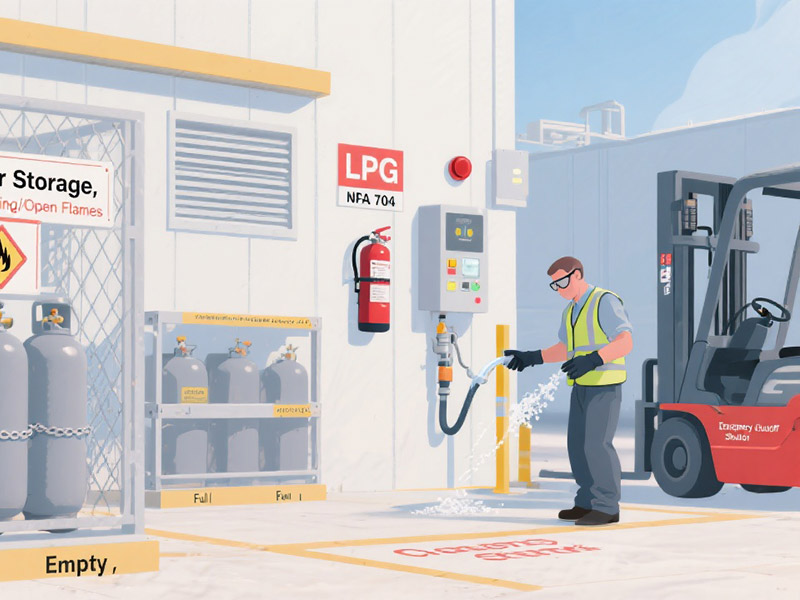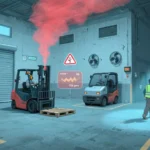The use of Liquefied Petroleum Gas (LPG) in industrial applications, particularly in material handling equipment like forklifts, operates within a comprehensive regulatory framework designed to protect workers, facilities, and the general public from the inherent hazards associated with flammable gases. This regulatory landscape encompasses federal occupational safety standards, national fire protection codes, and industry-specific guidelines that collectively establish the requirements for safe LPG handling, storage, and use.
Understanding and complying with these regulations is not merely a legal obligation—it represents a fundamental responsibility for protecting human life and property. The regulatory framework has evolved through decades of experience, incorporating lessons learned from incidents and advances in safety technology. Non-compliance can result in serious legal consequences, including citations, fines, criminal liability, and civil damages, while proper adherence ensures safe operations and regulatory compliance.
This article examines the key regulatory requirements governing LPG use, providing practical guidance for understanding and implementing compliance programs that meet or exceed regulatory standards.
OSHA Requirements for LPG Use
The Occupational Safety and Health Administration (OSHA) establishes and enforces workplace safety standards that directly impact LPG use in industrial environments.
General Duty Clause Requirements
OSHA’s General Duty Clause (Section 5(a)(1)) requires employers to provide workplaces “free from recognized hazards that are causing or are likely to cause death or serious physical harm.” This broad requirement applies directly to LPG use and requires employers to:
- Identify and assess LPG-related hazards in their workplaces
- Implement feasible measures to eliminate or minimize these hazards
- Provide appropriate training and protective equipment
- Maintain safe work practices and procedures
- Monitor compliance and effectiveness of safety measures
The General Duty Clause fills gaps not covered by specific standards and has been used to cite employers for LPG-related violations even when specific standards don’t directly apply.
Specific OSHA Standards for LPG
29 CFR 1910.110 – Storage and Handling of Liquefied Petroleum Gases: This comprehensive standard addresses LPG storage, handling, and use in general industry applications:
- Container specifications and testing requirements
- Installation standards for storage systems
- Safety relief valve requirements and testing
- Piping, tubing, and fitting specifications
- Transfer procedures and equipment requirements
- Fire protection and emergency response requirements
29 CFR 1910.178 – Powered Industrial Trucks: This standard specifically addresses LPG-powered forklifts and includes:
- Fuel system requirements and specifications
- Tank mounting and safety requirements
- Refueling procedures and safety protocols
- Maintenance and inspection requirements
- Operator training and certification standards
- Operational safety requirements for different environments
Workplace Safety Requirements
Ventilation Standards: OSHA requires adequate ventilation when using LPG equipment indoors. While specific ventilation rates aren’t always prescribed, employers must ensure that:
- Gas concentrations remain well below the Lower Explosive Limit (LEL)
- Adequate air exchange prevents vapor accumulation
- Ventilation systems are properly maintained and monitored
- Emergency ventilation procedures are in place
Training Requirements: OSHA mandates comprehensive training for workers who handle LPG or operate LPG-powered equipment:
- Hazard recognition training covering LPG properties and risks
- Safe handling procedures for refueling and maintenance
- Emergency response procedures for leaks, fires, and exposures
- Equipment-specific training for LPG-powered vehicles and equipment
- Refresher training to maintain competency and update knowledge
Personal Protective Equipment (PPE): Employers must assess PPE needs for LPG operations and provide appropriate equipment:
- Eye protection during refueling and maintenance operations
- Hand protection when handling LPG containers and connections
- Respiratory protection when exposure risks exceed safe levels
- Protective clothing for emergency response and maintenance activities
Record Keeping and Documentation
OSHA requires employers to maintain comprehensive documentation of LPG safety programs:
- Training records demonstrating employee competency
- Inspection and maintenance records for LPG equipment and systems
- Incident reports documenting accidents, near-misses, and exposures
- Safety program documentation including procedures and policies
- Equipment certifications and compliance documentation
NFPA Standards and Codes
The National Fire Protection Association (NFPA) develops consensus standards that form the foundation for fire safety regulations across the United States.
NFPA 58 – Liquefied Petroleum Gas Code
NFPA 58 represents the comprehensive standard for LPG systems and is widely adopted by local jurisdictions:
Storage Requirements:
- Container specifications including design, testing, and marking requirements
- Installation clearances from buildings, property lines, and ignition sources
- Capacity limitations for different installation types and locations
- Safety device requirements including relief valves and excess flow valves
Piping and Equipment:
- Material specifications for piping, tubing, and fittings
- Installation standards including supports, protection, and testing
- Regulator and control requirements for pressure reduction and safety
- Appliance connections and safety shutoff requirements
Safety and Emergency Provisions:
- Fire protection requirements including extinguishing systems and spacing
- Emergency procedures for leaks, fires, and system failures
- Personnel training requirements for installation and maintenance
- Inspection and testing schedules for ongoing safety verification
NFPA 505 – Fire Safety Standard for Powered Industrial Trucks
NFPA 505 specifically addresses fire safety for powered industrial trucks, including LPG-powered forklifts:
Fuel System Requirements:
- Tank mounting specifications and safety requirements
- Fuel line routing and protection standards
- Connection and disconnection procedures for safe fuel handling
- Leak detection and prevention requirements
Operational Safety:
- Refueling procedures and safety protocols
- Indoor use requirements including ventilation and monitoring
- Maintenance and inspection standards for fuel systems
- Emergency response procedures for fuel-related incidents
Training and Certification:
- Operator training requirements specific to LPG-powered equipment
- Maintenance personnel certification for fuel system work
- Safety awareness training for all personnel in LPG areas
- Emergency response training for fuel-related incidents
NFPA 30A – Code for Motor Fuel Dispensing Facilities
When applicable to LPG dispensing operations, NFPA 30A provides requirements for:
- Dispensing equipment design and installation
- Electrical equipment specifications for hazardous areas
- Fire protection and emergency response requirements
- Operational safety procedures and training
Industry Guidelines and Best Practices
Beyond regulatory requirements, industry organizations provide additional guidance for safe LPG operations.
Propane Education & Research Council (PERC) Guidelines
PERC develops industry-specific safety guidelines and training materials:
Forklift Safety Guidelines:
- Pre-operational inspection procedures for LPG systems
- Safe refueling practices and procedures
- Maintenance recommendations for optimal safety and performance
- Troubleshooting guides for common LPG system issues
Training Materials:
- Comprehensive training programs for operators and maintenance personnel
- Safety awareness materials for general personnel
- Emergency response procedures specific to LPG incidents
- Best practice recommendations based on industry experience
American Society of Safety Professionals (ASSP) Guidelines
ASSP provides comprehensive guidance for industrial safety programs:
Risk Assessment Methodologies:
- Hazard identification techniques for LPG operations
- Risk analysis procedures for quantifying LPG-related risks
- Control measure selection and implementation strategies
- Performance measurement and continuous improvement methods
Safety Management Systems:
- Program development guidance for comprehensive LPG safety programs
- Implementation strategies for effective safety management
- Performance monitoring and measurement techniques
- Continuous improvement methodologies
Compressed Gas Association (CGA) Standards
CGA develops technical standards for compressed and liquefied gases:
Equipment Standards:
- Container specifications and testing requirements
- Valve and fitting standards for LPG applications
- Safety device requirements and performance specifications
- Quality assurance and certification procedures
Handling and Transportation:
- Safe handling procedures for LPG containers
- Transportation requirements and safety protocols
- Storage and warehouse safety guidelines
- Emergency response procedures and equipment
State and Local Regulations
State and local jurisdictions often adopt and modify national standards to address specific regional concerns:
State Regulations
Adoption of National Standards:
- Most states adopt NFPA codes with state-specific modifications
- State fire marshals often have authority to interpret and enforce standards
- Some states have more stringent requirements than national standards
- Interstate commerce may be subject to federal DOT regulations
Licensing and Permitting:
- Installation permits required for LPG storage and handling systems
- Operating permits for facilities using significant quantities of LPG
- Personnel licensing for LPG installation and maintenance work
- Annual inspections and compliance certifications
Local Ordinances
Fire Department Requirements:
- Local fire codes often incorporate NFPA standards with modifications
- Inspection schedules and compliance verification procedures
- Emergency response planning and coordination requirements
- Fire protection system requirements and specifications
Building and Zoning Codes:
- Installation clearances and setback requirements
- Building construction requirements for LPG storage areas
- Ventilation requirements for indoor LPG use
- Occupancy limitations and safety requirements
Compliance Implementation Strategies
Developing effective compliance programs requires systematic approaches that address all applicable requirements:
Regulatory Assessment
Jurisdiction Analysis:
- Identify all applicable federal, state, and local requirements
- Understand enforcement agencies and their specific requirements
- Determine permit and licensing requirements
- Establish compliance timelines and milestones
Gap Analysis:
- Compare current practices with regulatory requirements
- Identify areas needing improvement or modification
- Prioritize compliance activities based on risk and regulatory priority
- Develop implementation plans and timelines
Program Development
Policy and Procedure Development:
- Create comprehensive written procedures addressing all regulatory requirements
- Establish clear roles and responsibilities for compliance activities
- Develop training programs that meet regulatory requirements
- Implement documentation and record-keeping systems
Training and Education:
- Provide initial training for all affected personnel
- Establish ongoing training programs and refresher requirements
- Document training completion and competency verification
- Maintain training records for regulatory compliance
Monitoring and Maintenance
Regular Audits:
- Conduct periodic compliance audits and assessments
- Identify and correct compliance deficiencies
- Update procedures based on regulatory changes
- Maintain documentation of compliance activities
Continuous Improvement:
- Monitor regulatory changes and updates
- Incorporate lessons learned from incidents and near-misses
- Benchmark against industry best practices
- Update programs based on operational changes and improvements
Enforcement and Penalties
Understanding potential enforcement actions and penalties emphasizes the importance of compliance:
OSHA Enforcement
Citation Types:
- Willful violations: Intentional disregard for requirements ($14,502 – $145,027 per violation)
- Serious violations: Substantial probability of death or serious harm ($14,502 per violation)
- Other-than-serious violations: Unlikely to cause death or serious harm (up to $14,502 per violation)
- Repeat violations: Previously cited violations ($145,027 per violation)
Criminal Referrals: OSHA may refer cases to the Department of Justice for criminal prosecution when:
- Willful violations result in worker fatalities
- False statements are made to OSHA investigators
- Advance notice of inspections is given to employers
Civil Liability
Personal Injury Claims:
- Regulatory violations can establish negligence in civil lawsuits
- Punitive damages may be awarded for willful regulatory violations
- Insurance coverage may be denied for regulatory non-compliance
- Corporate officers may face personal liability in some circumstances
Property Damage:
- Regulatory violations may void insurance coverage for property damage
- Third-party claims may result from LPG-related incidents
- Business interruption costs can be substantial following incidents
- Environmental cleanup costs may be required for contamination
Conclusion
The regulatory framework governing LPG use represents a comprehensive system designed to protect workers and the public from the significant hazards associated with flammable gases. Compliance requires understanding and implementing requirements from multiple sources, including OSHA standards, NFPA codes, and industry guidelines.
Successful compliance programs take systematic approaches that address all applicable requirements while fostering a culture of safety that goes beyond minimum regulatory compliance. Organizations that invest in comprehensive compliance programs not only meet their legal obligations but also create safer workplaces that protect their most valuable asset—their employees.
As regulations continue to evolve and safety technologies advance, maintaining current knowledge and adapting compliance programs accordingly remains essential for safe LPG operations. The investment in comprehensive compliance programs pays dividends through reduced incidents, lower insurance costs, improved regulatory relationships, and most importantly, protection of human life and property.



